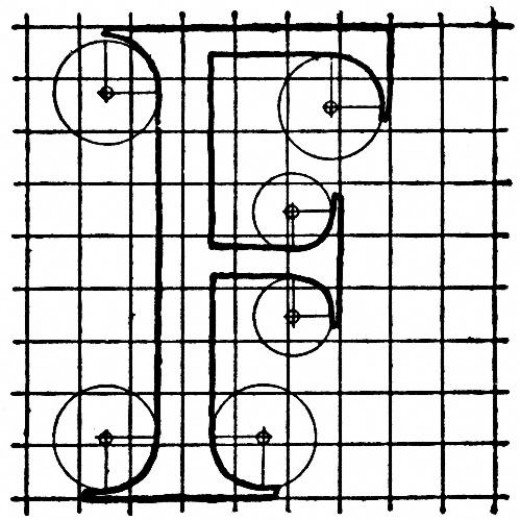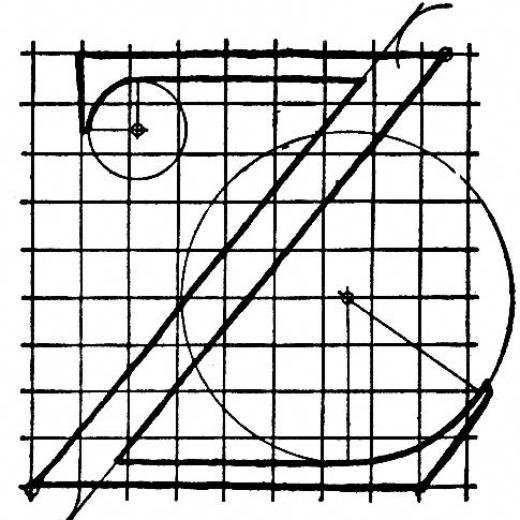Artist Entrepreneur: G for Goals — The Artist’s Alphabet Guide to Writing About Your Art by Aletta de Wal
Welcome to Artist Entrepreneur Fridays, where we talk about the fun, wild and scary ride of succeeding as an artist entrepreneur of all stripes and types and mediums.
Welcome back guest columnist, Aletta de Wal. She specializes in helping visual artists succeed in their fine art careers. She’s posting regularly on “The Artist’s Alphabet Guide to Writing About Your Art” and other success tips for fine artists around writing. This week it’s about goal setting — essential keys to business and artistic success. Enjoy!
***
When I ask artists what they want from their art, they often express states of being — happiness, joy, inner peace, good health, freedom from stress, self-esteem, attainment of knowledge, and changes of career direction. These are wonderful and I wish them for everyone. If you want to achieve them, you need to identify specific actions, people and places to bring you results that create those states of being.
Goals translate your dreams or vision into actionable, attainable deeds.
A visualization exercise where you imagine your future self in your successful life as an artist defines your ultimate goal. To achieve it, you need to break it down into manageable steps that take you from where you are now to where you want to be.
The acronym S.M.A.R.T.E.R. [1] is a simple, memorable way of breaking your vision down into actions and end points that you can monitor and adjust.
What Does the Acronym “S.M.A.R.T.E.R.” mean?
The S.M.A.R.T.E.R. acronym helps you remember an easy and efficient way to write down your goals. Each letter directs you to one of the seven elements of writing goals in a way that makes sure that you cover all the elements it takes to get from where you are to your end result. Just follow the steps in the acronym, and soon you will be planning like a professional!
| Letter | Meaning | Action |
| S | Specific | Set your intention and describe precisely what you will do. |
| M | Measurable | Decide what success is. How will you measure it? |
| A | Attainable | Stretch your comfort zone but not so far that you scare yourself. |
| R | Realistic | Assess whether you have the skills and the resources required. |
| T | Timed | Set a time frame to take these actions and review your results. |
| E | Energetic | Resolve to focus your energy to take action on your goals. |
| R | Rewards for Results | Decide on the rewards for achieving your goals. |
How to Write S.M.A.R.T.E.R. Goals
Let’s start with something most of us have done or want to do — get into better shape — so you can get more familiar with the process before you apply it to your career.
“S” Stands for “Specific”
Set your intention and describe precisely what you want to do. For example, if you want to get in shape, what does that mean? Do you want to be able to go up stairs without stopping to get your breath? Do you want to fit into your high school prom dress? Do you want to run a race and get to the finish line? See how much more specific these are than “get in shape?”
Please persevere on this one. The more detailed you are, the better. If you can convince yourself to write down the details, you’ll be amazed at how much easier it is to plan your days, weeks and months. If you cannot visualize what you have written, it is not specific enough for a goal.
“M” Stands for “Measurable”
Decide how you will know you have completed the goal. How many stairs do you want to go without stopping? Do you want to lose ten pounds, reduce your waist to twenty-six inches, for that prom dress? Is the race you want to run five miles, ten miles or a marathon of twenty-six miles?
Tracking your progress motivates you to take appropriate actions so that you continue to make that progress. The more progress you experience, the more motivated you will be to do the next step, and the next, and the next. You need clear milestones so that you get the full benefits of recognizing and celebrating what you create for yourself.
“A” Stands for “Attainable”
Stretch the comfort zone of your abilities, but not so much that you scare yourself! Goals you set beyond your true abilities or resources slow your progress on all counts. You usually berate yourself for not achieving them even though they were unrealistic for your abilities or the current level of your career.
Back to our example “to get in shape.” If you are more than twenty pounds overweight, it’s unlikely that you will run all the stadium stairs, get into that prom dress in a couple of weeks or run a marathon right away. But it is possible to do all of these eventually, if you put all the right actions in place and stick to them.
Assess your capacity in the area of this goal. Do you have the skills and the resources required to take the next step? If not, what do you have to do, learn, or add now? What specifically needs to be done, learned, or added?
Set goals that are too difficult and you may discourage yourself. Setting them too low sends the message (to yourself) that you aren’t capable. Set the bar high enough for a satisfying feeling of achievement when you succeed.
“R” Stands for “Realistic”
Make sure you have the determination, habits and willpower to do what it takes to reach your goal from where you are at the moment.
If you don’t much like walking in the outdoors, hate exercise that makes you sweat and love your food, say goodbye to the “get in shape” goal. Instead, you need to scale back the goal to something like walk up the stairs instead of taking the elevator, look for a form of recreation you like that gives your body a workout and decide to give up a few high calorie foods at least until you fit into that dress, or lower your blood pressure.
What will you realistically do without complaint on a regular basis so that you move from where you are now to closer to where you want to be? Do you have the drive to make art, the discipline to acquire business skills, and the consistent work habit required? If not, what do need to change about your attitude or expectations?
“T” Stands for “Timed”
Give yourself a deadline so you can schedule actions and milestones. Putting an end point on your goal gives you a clear point on the horizon to work towards. Set a time frame to take these actions and review your results as you go. If you don’t set a timeline, the commitment is too vague. The goal doesn’t happen because you feel you can start at any time. Without a time limit, there’s no urgency to start taking action now. There’s no driving need to take specific actions at specific times.
If you hope that one day you will get in shape, it may or may not happen. But if you want to look good at your high school reunion on June 25th or run the next race for Breast cancer in October, you can start making plans and scheduling actions. Break bigger goals down into interim milestones. Like one flight of stairs, two pounds a week or one inch, or four miles a month.
When will you take these actions, and at what intervals will you review your results? Have you done it before so you can feel sure that your time estimate is accurate? If you don’t have any experience with the action, you’d be wise to triple your time estimate. Do the actions need to be done in a certain sequence? Do any of the actions depend on the actions of other people? Do you know if their schedule fits yours? How can you build in “slippage” time so that the timeline is not too tight for comfort?
“E” Stands for “Energy”
Decide to concentrate your energy to work on your goals. Use your energy in a way that feeds your motivation to keep going towards the end results you want. You may want to lose weight or build your stamina, but do everything but going for your walk or lifting those weights until the day is gone and it’s too late.
To keep your energy flowing, it helps to focus on actions that increase and expand your feelings of well-being rather than leave you feeling depleted. Notice when you have that feeling of flow and resolve to do more of that kind of activity. Notice when tasks “take” energy and find ways to break them down into smaller pieces or ask someone else to do them for you.
“R” Stands for “Rewards for Results”
Give yourself a reward for persevering and achieving your results and acknowledge what it took to get them.
With a healthy diet and exercise plan, the results of a trim, toned body and lots of energy are the rewards of our hard work and willpower. Being able to fit into your favorite clothes or buy new ones, or go on a beach vacation are tangible rewards for our diligence.
To keep yourself motivated, write a list of what you will do when you achieve the goal. Some starter ideas are: do a “happy dance”, call a friend to share your satisfaction or get a larger studio space.
Here’s what happens when a visual artist puts the elements together.
Sample S.M.A.R.T.E.R. Goals
| I will create a signature style of art that I enjoy making, by painting daily with my art buddy, so that I will have a body of twenty pieces of work ready to exhibit in my home at a party for my favorite art friends by December 31st., 2xxx.I will set up all my business structure with a business license, bank account, filing, inventory system, and accounting system by working with an assistant, so that everything is in place and ready to operate by the end of January 2xxx and I will be able to submit my taxes with ease.I will produce a body of work that consists of four (4’ X 4’), eight (3’ X 3’) and two (4’ X 8’) paintings in iridescent acrylic glazes by June 30th, 2xxx. I will do this by working in my studio by myself three days a week for five hours and two days a week for three hours and when I have completed each piece to my satisfaction, I will buy something new for my studio.I will research ten different venues that are appropriate to the stage of my career. I will find out what kind of work they show, and meet the owners when I attend shows there. I will decide on three venues where I want to show my work and find out what criteria I have to meet to show in the venue. I will have this completed by September of next year before I go on my trip to New York to visit galleries. |
Having a series of milestones creates a situation where progress seems to “pull you forward.” One success literally builds on another. This gives you a solid feeling and confidence. Your confidence builds your competence as you build your success. I wish you your best year yet. Write on!
Next time, H for History.
[1] [1] Attribution S.M.A.R.T. The first known uses of the term occurred in the November 1981 issue of Management Review by George T. Doran.[1] http://en.wikipedia.org/wiki/SMART_criteria Thanks to Susan Birkenshaw for expanding S.M.A.R.T. to S.M.A.R.T.E.R.
***
Aletta de Wal, Artist Career Training
Aletta de Wal inspires fine artists to make a better living making art in any economy.
Aletta works with part-time, emerging and full-time visual artists who are serious about a career in fine arts. Aletta makes make art marketing easier and the business of art simpler.
More information at: http://www.artistcareertraining.com/artmatters-newsletter/








